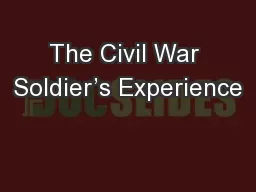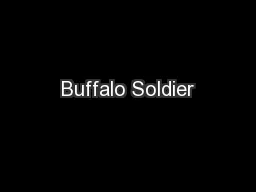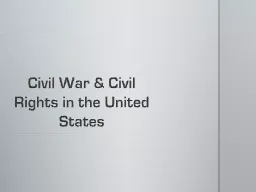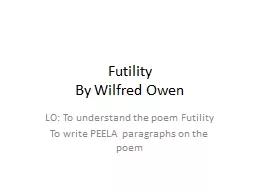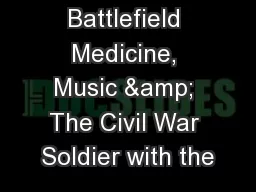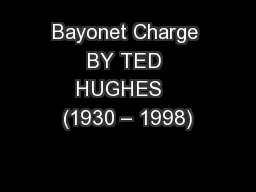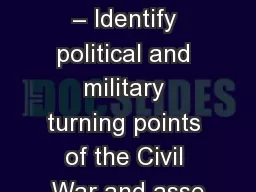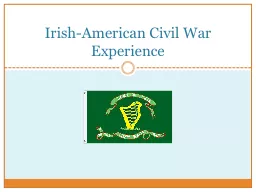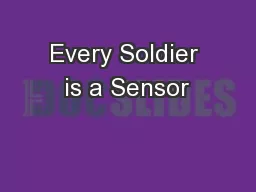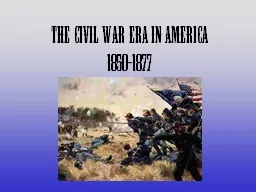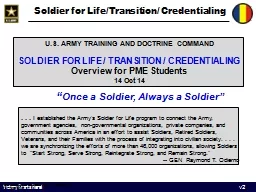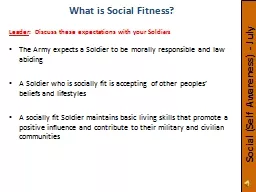PPT-The Civil War Soldier’s Experience
Author : briana-ranney | Published Date : 2018-09-16
MusicRecreation and Function I dont think we could have an army without music Robert E Lee 1864 Music held meaning beyond recreation and function Reindoctrination
Presentation Embed Code
Download Presentation
Download Presentation The PPT/PDF document "The Civil War Soldier’s Experience" is the property of its rightful owner. Permission is granted to download and print the materials on this website for personal, non-commercial use only, and to display it on your personal computer provided you do not modify the materials and that you retain all copyright notices contained in the materials. By downloading content from our website, you accept the terms of this agreement.
The Civil War Soldier’s Experience: Transcript
MusicRecreation and Function I dont think we could have an army without music Robert E Lee 1864 Music held meaning beyond recreation and function Reindoctrination. By Ted Hughes. Learning . Objective. To understand the context and subject matter of the poem.. The poem focuses on a nameless soldier in the First World War (1914-18).. It describes the experience of 'going over-the-top'. This was when soldiers hiding in trenches were ordered to 'fix bayonets' (attach the long knives to the end of their rifles) and climb out of the trenches to charge an enemy position twenty or thirty metres away. The aim was to capture the enemy trench. The poem describes how this process transforms a soldier from a living thinking person into a dangerous weapon of war.. Bob Marley. Colin Bennett. . . Buffalo soldier. , . dreadlock rasta. There was a buffalo soldier in the heart of America. Stolen from Africa. , brought to America. Fighting on arrival, fighting for survival. What was this war?. War fought between 1861-1865. Between the North (Union) and some Southern States (Confederacy). Why was this war fought?. Slavery – this was used primarily in the Southern United States especially on cotton and tobacco plantations. By Wilfred Owen. LO: To understand the poem Futility. To write PEELA paragraphs on the poem. Wilfred Owen. Wilfred Edward Salter Owen MC (18 March 1893 – 4 November 1918) was an English poet and soldier, one of the leading poets of the First World War. . BY TED HUGHES (1930 – 1998). GCSE Bitesize. http://www.bbc.co.uk/schools/gcsebitesize/english_literature/poetryconflict/bayonetcharge1.shtml. Bayonet Charge. Notice the impact of the adverb “suddenly” as the first word in the poem.. The Roman soldier dates back to circa 500 BC and continued to 1450 AD. This dates the influence of the Roman army on society to be about 2000 years. . This . army was the reason that Roman became a geo-political power, other than the appointment of the empire by God.. Texas . Civil War Museum . Music. Women in War. Medicine. The Civil War: Battlefield Medicine, Music & . The . Civil War Soldier with The . Texas . Civil War Museum. Outline . . I. Experience . . GCSE Bitesize. http://www.bbc.co.uk/schools/gcsebitesize/english_literature/poetryconflict/bayonetcharge1.shtml. Bayonet Charge. Notice the impact of the adverb “suddenly” as the first word in the poem.. significance to the outcome of the Civil War.. . Which 4 slaveholding states remained loyal to the Union? Why? What were they called?. Missouri, Kentucky, Maryland, Delaware. Slave-holding interests were minority in state legislatures. Before the War. First immigrant group to arrive in large numbers. Between 1800 and 1920, 5 million Irish men and women emigrated to the United States. Were only half involved in American culture. Were tasked with constructing an image of themselves as both Irish and Americans. Countering Corruption in Afghanistan. Amy Gaskins. Agenda. Quick Disclaimer. Why I’m Here. Redefining Data Science. Afghanistan Circa 2010. The 43d Sustainment Brigade. The Counter-. C. orruption Task. 1850-1877. The Main Idea. By 1850 the issue of slavery dominated national politics, leading to sectional divisions and, finally, the secession of the southern states.. Reading Focus. How did the issue of slavery influence expansion in the 1850s?. / Credentialing. U.S. ARMY TRAINING AND DOCTRINE COMMAND. SOLDIER FOR LIFE / TRANSITION / . CREDENTIALING . Overview . for PME Students. 14 Oct 14. POC: . Ms. Susan Schoeppler, TRADOC . G-3/5/7, (757) 501-5431 . The Army expects a Soldier to be morally responsible and law abiding A Soldier who is socially fit is accepting of other peoples’ beliefs and lifestyles A socially fit Soldier maintains basic living skills that promote a positive influence and contribute to their military and civilian communities
Download Document
Here is the link to download the presentation.
"The Civil War Soldier’s Experience"The content belongs to its owner. You may download and print it for personal use, without modification, and keep all copyright notices. By downloading, you agree to these terms.
Related Documents

